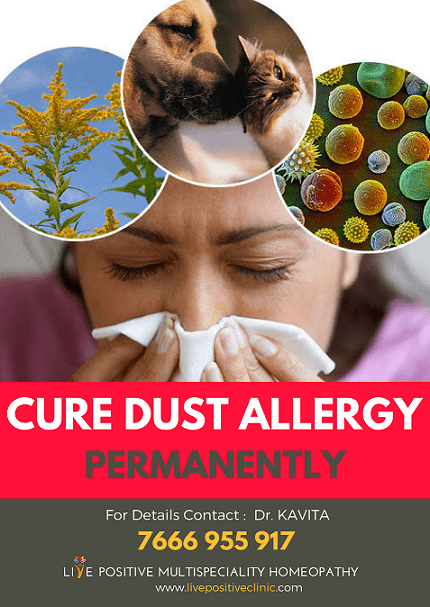Dust allergy is a common thing nowadays. Well, that should not come as a surprise because dust and pollution is something that is commonly seen across the globe.
Both the developed and the developing nations are struggling to combat rising levels of dust and other environmental pollution.
What is Dust Allergy?
Well, the term itself is quite self-explanatory. Dust allergy means that a person is allergic to dust and develops certain symptoms and discomfort when exposed to dust. The nature and severity of symptoms in each patient with dust allergy may vary.
Some patients develop sneezing and nasal discharge on exposure to dust, while others may start coughing and develop breathlessness.
There are many patients who develop irritation and itching of the skin on exposure to dust and some develop all of the above mentioned symptoms as well.
Dust Allergic Rhinitis
When the entire focus of the dust allergy symptoms is centered on the nose, then such patients are said to be suffering from dust allergic rhinitis.
In some patients, there are symptoms of sinus inflammation along with the nasal symptoms. Such patients are said to suffer from dust allergic rhinosinusitis.
Dust Allergic Rhinitis Symptoms
As mentioned earlier, type and severity of allergic rhinitis symptoms vary greatly from patient to patient. Here is a list of the most common symptoms of dust allergic rhinitis:
Sneezing-this could be just a few or numerous sneezes in short duration. Sneezing could be violent and spasmodic as well.
Nasal discharge-this could also vary. Mostly it is clear, watery and runny discharge dripping from the nose. In chronic cases, the discharge could thicken up as well.
Nasal Blockage-this could happen instantly due to swelling of the membranes lining the inside of your nostrils or could be delayed after a few hours or while lying down to sleep. Nose block could be partial or complete and in turn can lead to difficulty in breathing and mouth breathing.
Headache-this too could be mild or severe, one-sided or spread diffusely over the head. Sometimes if the patient suffers from migraine as well, then exposure to dust could trigger off a migraine headache too.
Disturbances in Smell, Taste or Hearing-these symptoms are usually seen when the attacks are severe and chronic. Repeated attacks of allergy could even lead to complete anosmia and loss of taste.
Irritation in the Passages-Irritation, tickling or itching internally within the passages of the nasal canal, ear canal or the posterior nares (back of the nostrils) and throat is a common concurrence. There could be itching in the eyelids, on the ears or even on the face or eyebrows as well. The internal itching in the passages aggravates more symptoms like sneezing, coughing, soreness of the throat or watering of eyes.
Fatigue-the sneezing or nasal discharges could be quite severe and violent that the patients are exhausted within a very short time. There is a feeling of tiredness and drowsiness and he/ she complains of lack of energy to do anything or study.
Dark Circles– Many patients have irritation in the eyes and eyelids along with the nasal symptoms. In such patients and also in others with chronic dust allergic rhinitis, dark circles form under or around the eyes.
Cause of Dust Allergic Rhinitis
Dust is something that all of us are exposed to in our daily lives. But not everyone suffers from dust allergy. Well that is because dust allergy is caused by an abnormal reaction of our immune system towards dust exposure.
The immune system in normal people does consider dust as a danger or threat to the body, so it does not react to exposure to dust in any way.
But in people with allergy, their immune system looks at dust as a dangerous threat that can cause damage to health and life. So their immune system jumps into combat mode and tries to shield the body from the dust attack by producing chemicals like histamine.
Histamine produces inflammation and that is how the allergic patient develops the symptoms like sneezing, nasal discharge, itching etc.
How to Cure Dust Allergy?
In all other systems of medicine except homeopathy, there is no permanent cure of allergy. Modern medicine or Allopathy manages the external symptoms of allergy by prescribing anti-histamines or corticosteroids.
This is not a cure or solution of the actual internal problem, but just a suppression of external symptoms.
Homeopathic medicines for allergy to dust can permanently cure allergic disorders by boosting and strengthening the immune system.
As you now already know, the actual problem is not in the dust or your nose or throat or eyes. The problem is in the immune system which is disturbed or disordered to such an extent that it fails to differentiate between a harmful and harmless substance like dust.
Live Positive Multispeciality Homeopathy has developed a specialized dust allergy treatment protocol that permanently cures dust allergic rhinitis and all types of allergic disorders by setting your disturbed immune system back in order.
During the process our homeopathic medicines reinforce your natural immunity and fortify it, thereby making your body stronger to combat infections, diseases and disorders.
Want to Get Rid of Dust Allergy Permanently?

